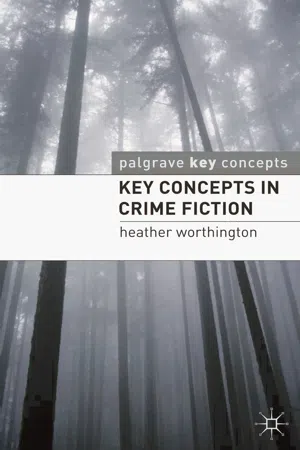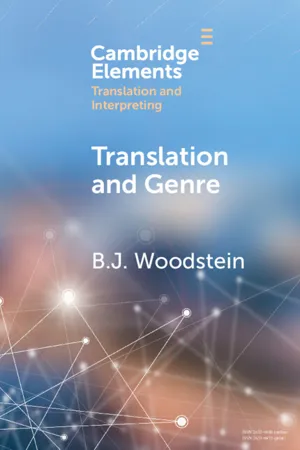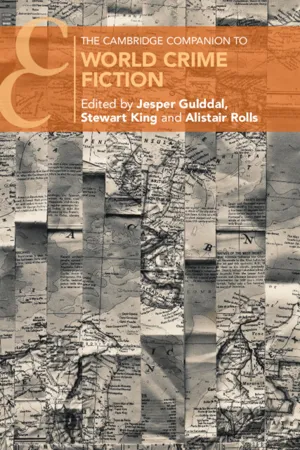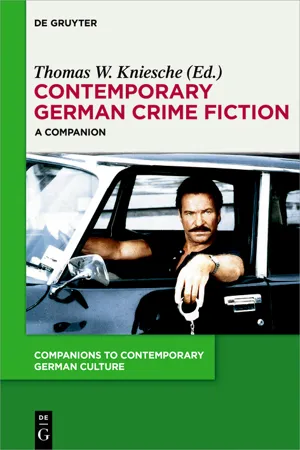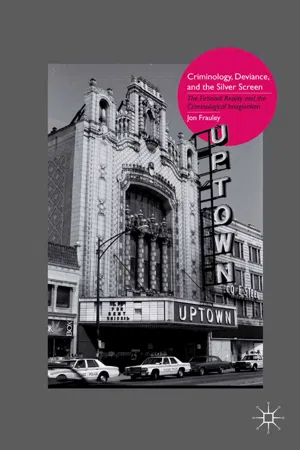Literature
American Crime Fiction
American Crime Fiction is a genre of literature that focuses on crime, its detection, criminals, and their motives. It emerged in the early 19th century and has since become a popular genre in American literature. The genre is known for its use of suspense, plot twists, and complex characters.
Written by Perlego with AI-assistance
Related key terms
1 of 5
6 Key excerpts on "American Crime Fiction"
- eBook - ePub
- Heather Worthington(Author)
- 2011(Publication Date)
- Bloomsbury Academic(Publisher)
There are, of course, omissions in this section; the very excess of sub-genres renders a comprehensive account impossible and is beyond the remit of this volume. But as in the previous section, each entry has a ‘Further Reading’ coda that will guide those readers wishing to expand their knowledge of crime fiction to other texts and where possible to critical material on, for example, Anglophone crime fiction from countries other than America and Britain, crime narratives in translation, the serial killer and forensic sub-genres. There are, however, two particular sub-genres of crime fiction that I explore which, unlike those listed above, have received little critical attention elsewhere: Children’s Crime Fiction and Historical Crime Fiction. Both sub-genres are relatively recent variants that are proving hugely popular and which once again demonstrate the adaptability of the genre as well as offering new insights into the reading public and the issues and topics with which they are concerned.American Crime FictionThe development of crime fiction in America both parallels and deviates from the British pattern. The seventeenth-century English settlers brought literary culture with them, but once the new settlements were established literature became strictly delimited by religion. Despite the strongly religious foundations of the early American settlers, crimes were committed within their communities as in any other society and serious crimes such as murder attracted the death penalty; as the convicted felon waited to be hanged on the gallows, he/she and those gathered to witness the event would be subjected to what became known as an execution sermon. These early crime narratives proved popular and the first book printed in Boston reproduced the sermon given at the execution of two men who had murdered their master: The Wicked Man’s Portion; or, A Sermon - eBook - PDF
- B. J. Woodstein(Author)
- 2022(Publication Date)
- Cambridge University Press(Publisher)
They have certain expectations and have ideas about the function of the text, and when those expectations are met, potentially also in a way that is aesthetically pleasing, they enjoy the reading experience, while also not having those expectations met can potentially lead to 37 Translation and Genre a stimulating experience too. Worthington writes, ‘Crime fiction is at once deeply conservative in its formulaic conventions and yet potentially radically in its diversity’ (2010, p. ix). Bradford sums up the genre by writing that no matter the subtype, crime fiction is about ‘constantly gathering evidence, attempting to make sense of patently unreal creations – by definition, puzzles – and close the gap between what we think we know and what the next page will tell us’ (2015, pp. 121–2). Given the many subtypes in this genre, it would be useful to think through what characteristics the texts in this field may contain. Palmer suggests that action is a key aspect and that the language usage emphasises the action. He writes that authors ‘dramatize a process’ so that ‘[a]ll actions, however mundane, become part of The Action, however insignificant’ (1979, p. 78). Palmer mentions other critics, who consider crime fiction ‘too corrupt and decadent’ (1979, p. 79), but he argues that a good thriller needs ‘a hero and a conspiracy’ and needs to ‘captur[e] the reader ’ s imagination’ (1979, p. 80). He adds that ‘what is specific to the thriller – what it is that attracts the thriller reader, whether critical or otherwise – is the view of the world that the thriller proposes’ (1979, p. 80). So generally, crime fiction contains action and a puzzle and tells readers something about their society, about ethics and what – or who – is considered ‘good’ versus ‘evil’. The resolution at the end of a crime work shows the values that a society holds dear. Porter writes that popular literature, such as crime fiction, serves as ‘a reflector and barometer of the society’ s ideological norms. - Jesper Gulddal, Stewart King, Alistair Rolls(Authors)
- 2022(Publication Date)
- Cambridge University Press(Publisher)
chapter 1 What Is World Crime Fiction? Jesper Gulddal and Stewart King Contemporary crime fiction is, emphatically, a global phenomenon. Not only is it a genre with seeming worldwide popularity but it is also a genre whose present and past can only be understood as a result of exchanges across national and indeed continental borders. ‘World crime fiction’ is the name we propose here for crime fiction considered as a global literary field – a field shot through with inequities and spanning an almost endless diversity of themes and forms, yet nevertheless united by tropes and traits recognized across the world as defining crime fiction. The global reach of the crime genre is evident from the fact that crime fiction is written, published, sold and read on a significant scale on all continents and in virtually all countries with an established literary culture; it often ranks among the most popular forms of literature, and where it does not, this is in itself a gauge of the cultural and political conditions of the country in question. The production of world crime fiction is trans- national in the sense of involving a merger between internationally circu- lating tropes and local literary traditions, which leads to the creation of new formats. 1 Its reception is equally transnational: the genre travels across borders with great ease in the form of licensed editions and translations, and readerships across the world display little hesitation with reading foreign crime fiction; indeed, the combination of familiar forms and unfamiliar, ‘exotic’ content has become one of the major selling points of global crime writing. Finally, crime fiction itself appears eminently suited to give literary form to the interconnectedness of the local, the national and the global that characterizes today’s world; this is not surprising as crime, criminal investigation and the provision of justice are themselves prime examples of such transnational linkages.- eBook - PDF
Books and Beyond
The Greenwood Encyclopedia of New American Reading [4 volumes]
- Kenneth Womack(Author)
- 2008(Publication Date)
- Greenwood(Publisher)
Detective and crime novels, novels of immigrant expe- rience, financial thrillers, and chick lit all remain popular fictional interpretations of city life. In an urbanized society few works, save perhaps those set in rural places, do not fall under the broadest definition of urban literature, and few works of urban literature cannot be placed in another genre. Settling on a useful definition requires shifting the focus from content to relationships between literary form and concep- tions of urban life. Historically certain forms emerged when existing genres seemed incapable of representing newly urban ways of life: realism and the industrial city; neighborhood fiction and ethnic communalism; modernism and the cultural metropolis; postmodern fiction and the city as a figure for under-construction states of mind. Contemporary popular works that adapt these forms and essay new ones are often marketed as “literary” or general fiction. Identified as aspirants to an artis- tic canon, critics and publishers generally eschew genre labels such as “urban” as incommensurate with such works’ capacity to interpret a cultural moment. History. The history of urban fiction broadly defined is a history of relation- ships between social and literary structures, as suggested in the aforementioned list of forms, whereas the more specific trajectory that leads to the current pub- lishing definition dwells in tales of particular urban subcultures, especially ethnic and racial, and in linguistic styles associated with them—types of content and narrative rhetoric that often formalize perceived social division. The following summary traces these latter elements as they arise in the broader development of the category. - eBook - ePub
Contemporary German Crime Fiction
A Companion
- Thomas W. Kniesche(Author)
- 2019(Publication Date)
- De Gruyter(Publisher)
Often cast as a desperate, even pandering attempt to attract students to the study of literature at a time of plummeting enrolments in the humanities, teaching crime fiction is frequently more tolerated than admired. One holds one’s nose and wishes for the good old days of Chaucer, Milton, Keats and Shelley. Put in these rather stark terms, it is of course hard to disagree with this charge. Who would not want to keep the focus of attention on Shakespeare – if for no other reason than his dogged reappearance throughout contemporary culture? But rarely is the study of crime fiction in actuality such a crass, zero-sum game. It need not displace the classics, nor should it. Moreover, adding a course on a genre with which students are – as studies have shown – more likely to engage throughout their lives (if they read at all) offers a number of palpable advantages, as we discovered at Duke a number of years ago.Undemanding, formulaic, lowbrow: we have heard these charges many times, and they appear to have lingered longer in Germany than in the US. This is of some importance when considering the inclusion of crime fiction within the German studies curriculum at a US college or university, for these departments are far more likely to be deeply connected to – and therefore influenced by – the long-standing German disdain for crime fiction. For that reason, it makes sense briefly to review the situation here.From the beginning, Kriminalliteratur led a dual life: popular within larger demographic groups, but disparaged or dismissed by the normative literary institutions of high culture, including literary critics, libraries and universities.3 In Germany, the aesthetic and moral denigration of crime fiction goes hand in hand with the larger marginalization of Unterhaltungsliteratur or U-Literatur [entertainment literature] in favour of ernste Literatur or E-Literatur [serious literature], a distinction that harkens back to German classicism. This binary distinction, which simultaneously degrades genre literature as well as other forms of so-called Trivialliteratur - eBook - PDF
Criminology, Deviance, and the Silver Screen
The Fictional Reality and the Criminological Imagination
- J. Frauley(Author)
- 2010(Publication Date)
- Palgrave Macmillan(Publisher)
Criminology and Its Relation to the Fictional Reality: Three Views There is a growing but fragmented body of literature within crimi- nology and criminal justice studies that takes fiction as its object of inquiry. On the one hand, there is an exploration of representations of popular attitudes toward crime or how criminological themes and issues are reflected in film and literature (Fiddler 2007; Gehrke 2001; O’Brien et al. 2005; Pearce 1978; Rafter 2006, 2007; Ruggiero 2002, 2003; Tzanelli, Yar, and O’Brien 2005). On the other hand, literature has been explored for how it might be used to exemplify sociological and criminological concepts—that is, the major ideas criminologists and sociologists work with to describe and explain what they are studying (Engel 2003; Hagan and Benekos 2002; Laz 1996; West 2005). Both bodies of literature, although not unified, are con- cerned with the fictional reality. Broadly, the first body of literature explores the intersection of criminology and popular culture to push the boundaries of criminological theory, research and, understanding. The second approach explores how criminological research, theory, and understanding can be represented to students and scholars alike. These studies have helped to legitimate investigation of fictional reali- ties as objects of criminological inquiry. The work by Jeff Ferrell and cultural criminologists has helped to explicitly identify popular culture, especially “everyday life,” as some- thing of criminological interest. Traditional criminological objects of study include crime, criminality, official crime control, victimiza- tion, and to a lesser extent, the political process of criminalization (the production of categories of crime). A fundamental argument of cultural criminology is that these criminological objects can be made much more intelligible if approached as cultural practices or practices that in some way seek to produce or reproduce culture.
Index pages curate the most relevant extracts from our library of academic textbooks. They’ve been created using an in-house natural language model (NLM), each adding context and meaning to key research topics.
